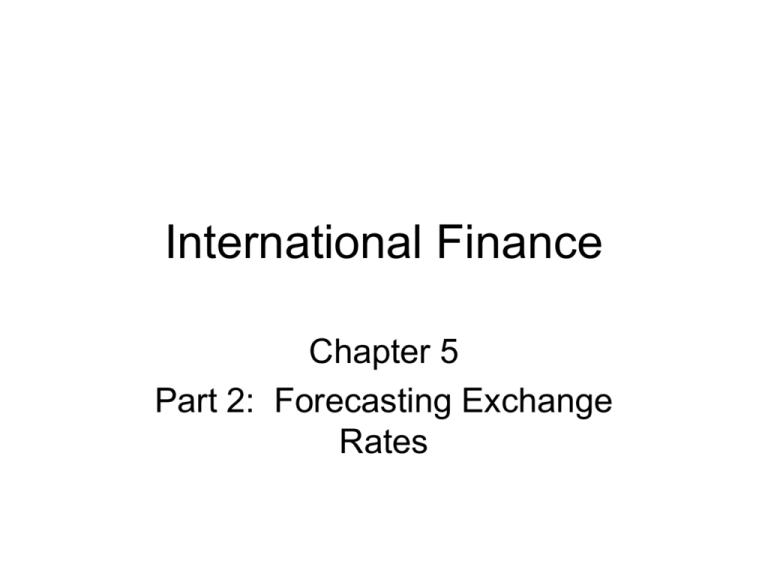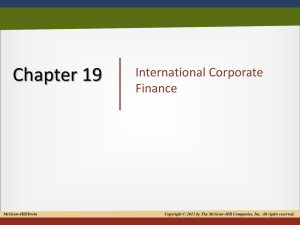International Finance
advertisement

International Finance Chapter 5 Part 2: Forecasting Exchange Rates FORECASTING EXCHANGE RATES • Why is it important to do so? THREE APPROACHES TO FORECASTING • Efficient Market Approach – Applicable for short term (days out to a couple of months) • Technical Approach – Applicable for short term (days out to a couple of months). • Fundamental Approach – Non-parity models: intermediate term (out to a couple of years) – Parity models: long term (2 years plus) EFFICIENT MARKETS APPROACH • Assumes FX markets are efficient. – Current spot prices capture all relevant information! – Spot exchange rates will only occur when the market received “new” information. – Since “new” information is unpredictable, exchange rates will change randomly over time. EFFICIENT MARKETS FORECASTING • Future spot rates are assumed to be independent of past rates. – “Random Walk.” • What do we use to forecast? – The current spot rate or – The current forward rate. EFFICIENT MARKET SUMMARY • Benefits: – Easy to use. – Costless (spot and forwards are public rates). • Disadvantages: – Only way to beat the market is if you have “insider” information. • May be useful for short term periods!! TECHNICAL ANALYSIS • Examines past price data to identify “patterns.” – Relies on charts! • Patterns can be used to signal future moves in rates. – Suggests that prices are not random! – Method at odds with efficient market approach. TECHNICAL ANALYSIS • Market Momentum – Examine past charts to identify if market momentum exists. • Last two years, last 3 months, last month • Compare daily moves to trend • Examine extremes – What is the trend in market momentum? • Use UBC web-site to chart data. – http://fx.sauder.ubc.ca/ EURO: LAST 2 YEARS EURO: PAST 91 DAYS EURO: PAST MONTH DAILY SPOT TO TREND • Moving Average Cross Over Rule • Compare current spot rate to longer term (90 or 180 day) moving average of past spot rates. • Look for crossover of two series: – If current spot crosses trend on way up, this is a signal of currency strength. – If current spot crosses trend on way down, this is a signal of currency weakness. SPOT TO 90 DAY MOVING AVERAGE BOLLINGER BANDS • Bollinger Bands: – Allows for comparison of volatility and relative price levels over a period of time. The indicator consists of three bands designed to encompass the majority of a foreign exchange’s price action. 1. A simple moving average (SMA) in the middle 2. An upper band (SMA plus 2 standard deviations) 3. A lower band (SMA minus 2 standard deviations) • Standard deviation is a statistical term that provides an indication of the currency’s volatility. INTERPRETATION OF BOLLINGER BANDS • Bollinger Bands are designed to capture the majority of a currency’s price movement. – When prices move above the upper band, they are considered high (overbought) on a relative basis. • Signal of future weakness in currency – When prices move below the lower band, they are considered low (oversold) on a relative basis. • Signal of future strength in currency BOLLINGER BANDS: 90 DAY AVERAGE (GREEN LINE) FUNDAMENTAL ANALYSIS • What are the relative economic forces that drive the spot exchange rate? • Non-Parity Models: – Assets Choice Model – Balance of Payments Model • Both combined with “government intervention activity.” • Both combined with “country risk assessment.” • Parity Models – Purchasing Power Parity – International Fisher Effect ASSET CHOICE MODEL • What are the major economic and financial variables that will result in an increase (or decrease) in the demand for a particular foreign currency. – Increase in demand will cause the currency to strengthen. – Decrease in demand will cause the currency to weaken. ASSET CHOICE VARIABLES • Relative Interest Rates – Countries with relatively higher short term interest rates will experience increased short term capital inflows. – Inflows of short term capital will strengthen a currency. • Examine current short term interest rates in the two countries • Assess the likelihood of changes in short term interest rates in both countries CURRENT SHORT TERM INTEREST RATES • Use Bloomberg or the Economist (or other sources) for current short term interest rates. – http://www.bloomberg.com/markets/rates/inde x.html – http://www.economist.com/ ASSESSING FUTURE SHORT TERM INTEREST RATES • Where are short term interest rates likely to move over the period of your forecast? • What are the major factors that will impact on short term interest rates? – Economic activity. – Central bank actions. • Need to assess both of these. • Also look at yield curves to market’s expectation regarding future moves in short term rates. CENTRAL BANK ANNOUNCEMENTS • Visit the web sites of central banks for latest announcements and past decisions. • http://www.bis.org/cb/index.htm OTHER POSSIBLE SHORT TERM ASSET CHOICE FACTORS • Equity Market Performance – Strong equity markets will also pull in capital from foreign investors – Capital inflows will strengthen a currency. • Assess recent moves in equity markets. • What is the outlook for equity markets over the period of the forecast? GOVERNMENT INTERVENTION POLICIES • Governments occasionally intervene in foreign exchange markets to support their currency. – Selling a strengthen currency – Buying a weakening currency • Government intervention can affect the exchange rate and hence the error of the forecast. GOVERNMENT INTERVENTION • Need to assess the likelihood of government intervention during the period of the forecast. • Some central banks are much more prone to use intervention. COUNTRY RISK ASSESSMENT • Generally speaking, markets tend to discount high risk environments. – Tends to weaken a currency • Need to assess country risk – Political and economic risk factors. • One source of country risk is Institutional Investor Magazine. • Another source, relating to corruption, is Transparency International. SOURCES OF DATA • http://www.transparency.org/ – Go to “Corruption Surveys.” • Institutional Investor Magazine – In Business School Library BALANCE OF PAYMENTS MODEL • Examine a country’s balance of payments to determine possible exchange rate impacts. – High (trade and current account) deficit countries need a lot of foreign capital to finance these deficits. – Tends to put downward pressure on the exchange rate of these countries. PARITY MODELS • Purchasing Power Parity Model – Use absolute PPP to assess whether or not a currency is currently over or undervalued. – Big Mac Index or OECD data. • Use forecasts of expected inflation to estimate changes in spot rates for the time period of the forecast. – The Economist Magazine as one source. • “Economic and Financial Indicators section.” PARITY MODELS • International Fisher Effect – Collect market interest rate data for the period of the forecast. – For example, a ten year forecast would necessitate looking at ten year government securities. • Based on market interest rate differentials, estimate future spot rates for the time period of the forecast SOURCE OF MARKET INTEREST RATE DATA • Bloomberg • The Economist Magazine • Economic and Financial Indicators section.” • Make sure the maturity of the securities matches the time period of the forecast!





